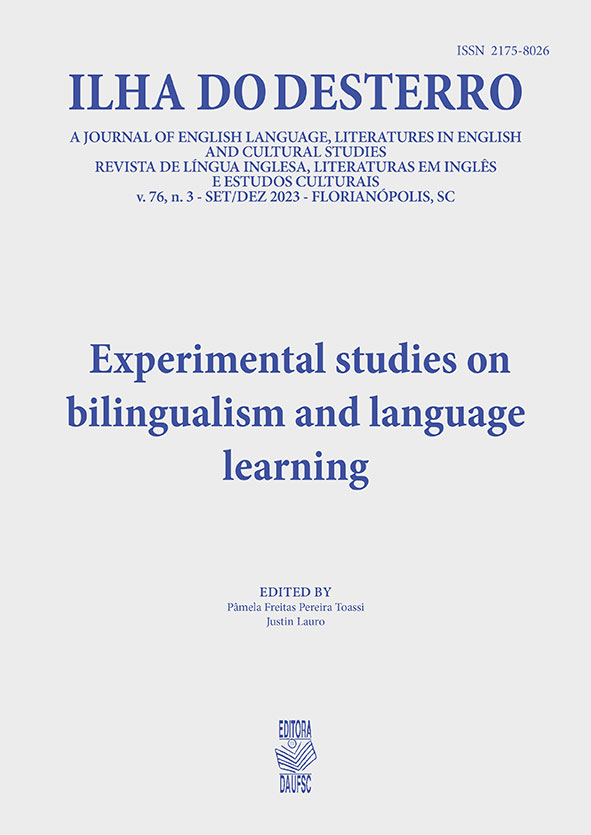Effect of Interlingual Homographs and Word Frequency on Bilingual Lexical Access
DOI:
https://doi.org/10.5007/2175-8026.2023.e94613Keywords:
Bilingualism, lexical access, interlingual homographs, word frequencyAbstract
In two experiments, a language decision task, and a multiple-choice English-Portuguese translation task, we examined the effect of interlingual homographs and word frequency on lexical access of Brazilian-Portuguese - English bilinguals. Language choice, accuracy, and response times were registered by the PsyToolkit software, and linear mixed-effects models were used in the analysis of the data. The results of this study align with the non-selective lexical access hypothesis. Bilinguals had facilitated access, particularly for words in the L2. There was also an interference effect of word frequency observed in both the L1 and L2 for interlingual homographs.
References
Baayen, R. H. (2008). Analyzing linguistic data: A practical introduction to statistics. Cambridge: Cambridge University Press.
Baayen, R. H., Davidson, D. J., & Bates, D. M. (2008). Mixed effects modeling with crossed random effects for subjects and items. Journal of Memory and Language, 59, 390-412.
Bates, D., Maechler, M., Bolker, B., & Walker, S. (2015). Fitting linear mixed-effects models using lme4. Journal of Statistical Software, 67, 1-48.
Barcelos, L., & da Luz Fontes, A. B. A. (2021). O processamento de cognatos e falsos cognatos por brasileiros falantes de português, inglês e francês. Revista Linguagem em Foco, 13(4), 37-55.
Brysbaert, M., & New, B. (2009). Moving beyond Kucera and Francis: A critical evaluation of current word frequency norms and the introduction of a new and improved word frequency measure for American English. Behavior Research Methods, 41, 977–990. http://dx.doi.org/10.3758/ BRM.41.4.977
Core Team, R. (2017). A language environment for statistical computing. Vienna, Austria: R Foundation for Statistical Computing. https://www.R-project.org/.
Dijkstra, T., De Bruijn, E., Schriefers, H., & Ten Brinke, S. (2000). More on interlingual homograph recognition: Language intermixing versus explicitness of instruction. Bilingualism: Language and cognition, 3(1), 69-78.
Dijkstra, T., Grainger, J., & Van Heuven, W. J. (1999). Recognition of cognates and interlingual homographs: The neglected role of phonology. Journal of Memory and language, 41(4), 496-518.
Dijkstra, T., Moscoso del Prado Martín, F., Schulpen, B., Schreuder, R., & Harald Baayen, R. (2005). A roommate in cream: Morphological family size effects on interlingual homograph recognition. Language and Cognitive Processes, 20(1-2), 7-41.
Dijkstra, T., Van Jaarsveld, H., & Ten Brinke, S. (1998). Interlingual homograph recognition: Effects of task demands and language intermixing. Bilingualism: Language and cognition, 1(1), 51-66.
Durlik, J., Szewczyk, J., Muszy?ski, M., & Wodniecka, Z. (2016). Interference and inhibition in bilingual language comprehension: Evidence from Polish-English interlingual homographs. PloS one, 11(3), e0151430.
Elston-Güttler, K. E., Gunter, T. C., & Kotz, S. A. (2005). Zooming into L2: Global language context and adjustment affect processing of interlingual homographs in sentences. Cognitive Brain Research, 25(1), 57-70.
Estivalet, G. L., & Meunier, F. (2017). Corpus psicolinguístico Léxico do Português Brasileiro. Soletras, (33), 212-229.
Gadelha, L. M. da S., & Toassi, P. F. P. (2022). Acesso lexical de palavras homógrafas interlinguísticas português brasileiro: Inglês em uma tarefa de decisão linguística e de tradução. Revista Linguagem Em Foco, 13(4), 56–77. https://doi.org/10.46230/2674-8266-13-7368
Gollan, T. H., Montoya, R. I., Cera, C., & Sandoval, T. C. (2008). More use almost always means a smaller frequency effect: Aging, bilingualism, and the weaker links hypothesis. Journal of Memory and Language, 58(3), 787–814.
Gollan, T. H., Slattery, T. J., Goldenberg, D., Van Assche, E., Duyck, W., & Rayner, K. (2011). Frequency drives lexical access in reading but not in speaking: the frequency-lag hypothesis. Journal of Experimental Psychology: General, 140(2), 186.
Ivanova, I., & Costa, A. (2008). Does bilingualism hamper lexical access in speech production?. Acta psychologica, 127(2), 277-288.
Jared, Debra, & Szucs, Carrie. (2002). Phonological activation in bilinguals: Evidence from
interlingual homograph naming. Bilingualism: Language and Cognition, 5 (3), 225-239. https://doi.org/10.1017/S1366728902003024.
Kerkhofs, R., Dijkstra, T., Chwilla, D. J., & De Bruijn, E. R. (2006). Testing a model for bilingual semantic priming with interlingual homographs: RT and N400 effects. Brain research, 1068(1), 170-183.
Lemhöfer, K., Dijkstra, T. (2004). Recognizing cognates and interlingual homographs: Effects of code similarity in language-specific and generalized lexical decision. Memory & Cognition 32, 533–550. https://doi.org/10.3758/BF03195845
Poort, Eva. D., & Rodd, Jennifer. M. (2022). Cross-lingual priming of cognates and interlingual homographs from L2 to L1. Glossa Psycholinguistics 1(1): 11, pp. 1–33. DOI: https://doi.org/10.5070/G601147
Poort, E. D., & Rodd, J. M. (2017). The cognate facilitation effect in bilingual lexical decision is influenced by stimulus list composition. Acta Psychologica, 180, 52-63.
Poort, E. D., Warren, J. E., & Rodd, J. M. (2016). Recent experience with cognates and interlingual homographs in one language affects subsequent processing in another language. Bilingualism: Language and Cognition, 19(1), 206-212.
Stoet, G. (2010). PsyToolkit - A software package for programming psychological experiments using Linux. Behavior Research Methods, 42(4), 1096-1104.
Stoet, G. (2017). PsyToolkit: A novel web-based method for running online questionnaires and reaction-time experiments. Teaching of Psychology, 44(1), 24-31.
Vanlangendonck, F., Peeters, D., Rueschemeyer, S. A., & Dijkstra, T. (2020). Mixing the stimulus list in bilingual lexical decision turns cognate facilitation effects into mirrored inhibition effects. Bilingualism: Language and Cognition, 23(4), 836-844.
van Heuven, W. J. B., Mandera, P., Keuleers, E., & Brysbaert, M. (2014). SUBTLEX-UK: A new and improved word frequency database for British English. Quarterly Journal of Experimental Psychology, 67, 1176–1190.
Vingron, N., Furlani, N., Mendelson, O., & Titone, D. (2022). I see what you mean: Semantic but not lexical factors modulate image processing in bilingual adults. Memory & Cognition, 50(2), 245-260.
Whitford, V., & Titone, D. (2017). The effects of word frequency and word predictability during first-and second-language paragraph reading in bilingual older and younger adults. Psychology and aging, 32(2), 158.
Downloads
Published
Issue
Section
License
Copyright (c) 2023 Pâmela Freitas Pereira Toassi, Justin Lauro, Liana Maria da Silva Gadelha, Maria Teresa Carthery-Goulart

This work is licensed under a Creative Commons Attribution 4.0 International License.

This work is licensed under a Creative Commons Attribution 4.0 International License.



